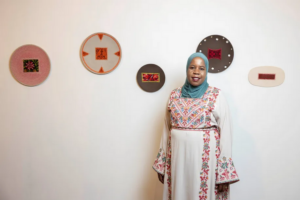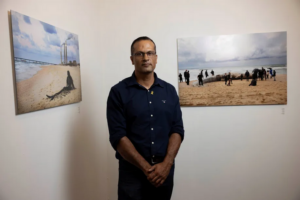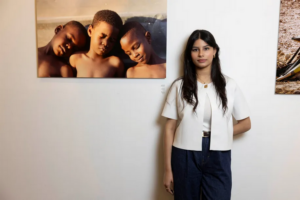‘We’re more than stories of violence & crime’: Israeli Bedouin artists challenge Tel Aviv’s gallerygoers

Zenab Garbia with some of her artwork at the Rosenfeld Gallery exhibition, September 2024
Nagham Zbeedat reports in Haaretz on 11 September 2024:
As the crowd hurries through a narrow corridor, an excited voice calls out, “I can’t wait to see the Bedouin art!” At the Rosenfeld Gallery in south Tel Aviv, a new exhibit – “Wakat Al-Nakab” (“Negev Time”) – is currently showcasing the work of a group of aspiring and accomplished artists from this long-underrepresented community in southern Israel.
The gallery’s walls are adorned with a diverse collection of work – paintings, intricate embroidery, striking photographs that capture timeless moments. Through their craft, these artists aim to convey a powerful message to the rest of Israel: the Bedouin community of the Negev is much more than the lazy stereotype often presented in the local media.
This pop-up exhibition is curated by Ariel Ram Pasternak and runs until September 14. It offers a rare, unfiltered glimpse into an embattled community of over 300,000 people. About two-thirds live in towns and cities, and the other third in unrecognized villages throughout southern Israel – with many of the latter in homes at risk of demolition from a state looking to build Jewish towns in the area.
An initiative of the Stars Accelerator program by Desert Stars (an Israeli nonprofit focused on developing the leadership skills of Bedouin youth), the exhibit showcases the talents of artists such as Eiman Abu Ghanem, Ala Abu Aliyon, Hoda Alamrane, Hazar Abu Al-Hani, Zenab Garbia and others.
‘Showing both sides’
Photographer Waleed Al-Obra tries to capture some of the challenges the Bedouin of Israel face – both as people who are dealing with changes in lifestyle and tradition, and as a minority in a Jewish state where they are often discriminated against, even though many of them serve in the army and integrate in society. “I try to show both sides: the struggles and despair that we encounter, and the joy and love for life that we cherish in spite of everything,” he says. The 41-year-old says he wants to be known for more than being just a wedding photographer (he also works as a news photographer and documentarian). “I try to capture our daily lives, especially the struggles we the Bedouin community are now facing,” he explains.
Unlike other Israelis, who can go to the relevant government ministry to air their grievances, the fate of the Bedouin lies in the hands of a government agency called the Authority for Development and Settlement of the Bedouin in the Negev.
The term “development” could be seen as somewhat ironic, because in the 17 years since the agency’s establishment, there has been no improvement in the standing of any Bedouin community in the Negev: they are all stuck at the bottom of the country’s socioeconomic index.

Artist Yusuf Huzaiel standing in front of some of his artworks at the Negev Time exhibition, September 2024
One of the most staggering examples of how the Bedouin community is treated by the state is the lack of protection it has from missiles. Israel’s Iron Dome defense system, that is designed to intercept threats on populated areas, doesn’t protect many unrecognized villages. There is also a severe shortage of protected spaces: the only Israeli who was injured during the Iranian attack on Israel in April was seven-year-old Amina al-Hassouni from the unrecognized village of Al-Fura. Her case made some headlines, but the conditions in the villages remain mostly unchanged.
Instead of focusing on the actual development of Bedouin communities, the authority is instead seemingly preoccupied with plans to relocate them from their lands – lands whose ownership remains disputed, at least from a Bedouin perspective.
“Almost on a daily basis we witness a home being demolished,” says Al-Obra, highlighting the fact that home demolitions – even during wartime – are seen as a bigger threat than missiles. “We’re also experiencing an increase in public racism, directed not just at the Arab community but particularly at the Bedouin people in Israel.”
Long-standing traditions such as Bedouin hospitality and ceremonial folk dances remain significant in modern Arab culture. One of the most prominent customs is the Bedouin wedding – a vibrant celebration filled with color and music. These weddings reflect the true spirit of the desert nomads and embody the ancient Arab concept of marriage as the union of two families, not just two individuals.
These joyous moments, Al-Obra reflects, are “a testament that, despite the struggles and the Israeli government’s attempts to suffocate us, we are still capable of expressing joy and a strong will to live.”
Multidisciplinary artist Zenab Garbia, a mother of five from the southern town of Shaqib al-Salam, says her biggest challenge in life was convincing her brother that she should finish high school. Haaretz reported last year that one in six Bedouin between the ages of 16 and 17 do not attend high school, and in unrecognized villages the dropout rate is as high as 25 percent. (The dropout rate among Jewish Israelis of the same age is 3 percent.)
In Bedouin culture, women are often expected to marry young, bear children and follow societal norms where the husband holds decision-making power both inside and outside the home. Before her marriage, Garbia’s brother was responsible for her choices, including whether or not she could return to school – a decision he refused to support. “I’m deeply grateful for my husband’s support,” says the 52-year-old artist. “He encouraged and helped me pursue my education, despite my brother’s objections.”
Despite the support from her husband, it was her mother’s example that truly inspired the artist: Garbia broke with tradition to pursue her dream of finishing high school, and even received a higher education at Kaye Academic College of Education in Be’er Sheva. “My mother is my greatest inspiration,” she says. “She married my father, who was almost 40 years her senior. She was only 14 at the time and was widowed at 24, left to provide for five children on her own.”

Hazar Abu Al-Hani next to some of her artwork at ‘Negev Time’ exhibition, September 2024
Her mother was among the first Bedouin women to work outside the home, Garbia says, securing a job in farming. “I worked in farming too, until a serious accident,” the artist recounts, describing the pivotal moment that made her reassess her path. “I didn’t want to risk my life in farming anymore.” So, over the past two decades, she has nurtured a hitherto hidden talent for embroidery. “I didn’t even know I was capable of this,” she says.
Women’s traditional crafts, such as embroidery, beading and weaving, have been integral to everyday Bedouin life, with skills typically passed down from mother to daughter. While Garbia’s mother primarily relied on agriculture for income, she also embroidered traditional Bedouin dresses and passed this skill on to her daughter.
Garbia has since fused her ceramic work with Bedouin embroidery, creating a unique and innovative form of art that honors her heritage.
What price art?
Appreciation of art within Bedouin culture has long been a challenge for artists – from the more experienced like Garbia, to aspiring young talents such as Eiman Abu Ghanem and Rana Al-Odat.
Abu Ghanem sums up the skepticism of many in her community toward the medium thusly: “How would a piece of art benefit me?” “It was hard to explain to the people around me that I wanted to study art,” says the 21-year-old student, recalling the discouraging comments she received over her academic choices. “They thought art was limited to a paintbrush and a blank canvas.”
Abu Ghanem, who hails from the only Israeli Bedouin city, Rahat, has a degree in art studies and is pursuing a master’s in informal education. Unlike the common misconception about art within her community, she sees it is a vital tool for self-expression.
“When my grandfather passed away, I found myself sitting down to paint in the middle of the night,” she remembers. “My family thought I’d gone mad – but without art I don’t know how else I would have coped.”
The young artist faces significant challenges in selling her work. Beyond the lack of appreciation from her own community, she also struggles to put a price on her pieces. “I often spend around eight hours working on a single piece,” she explains. “It’s worth far more than any price tag.” One of her most striking creations, a painting of the map of Palestine/Israel with embroidered detailing on the southern part, titled “The Negev in the Eye of Tradition,” is available to purchase at the exhibit for 2,800 shekels (about $740).
Her friend, Rana Al-Odat, also 21, sells embroidery pieces on social media and is encountering a different experience: community recognition. “I only started doing embroidery during the [Gaza] war,” she says. “I never expected this outcome, or to be where I am now.” Despite her relatively recent foray into the art world, Al-Odat says she is seeking to challenge a long-standing stereotype.
The Bedouin community in the Negev has been depicted in the Israeli media primarily in connection with criminal activity or disputes over land control. “We’re more than just stories of violence and crime,” Al-Odat stresses. “We rarely make the news unless it’s for crime, yet we have doctors, educators, lawyers – we’re more than what the media portrays.”
‘Sons of this land’
Zamir Shatz, a peace advocate and artist who has long engaged with Bedouin society through his paintings and personal interactions with Negev residents, is the only Israeli-Jewish artist to feature in the exhibit. He says that growing up around Bedouin workers, he developed a deep understanding of their culture and traditions. “I believe the Bedouin are the sons of this land,” the 55-year-old says. “Unless the Bedouin receive their rights and a fair position in Israel, this state will never fully achieve a complete and just society for all its citizens,” he sums up.
This article is reproduced in its entirety
